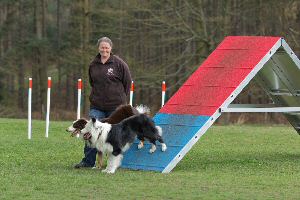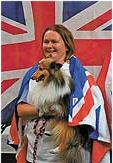|
More evolution than revolution...
 Nicola
Garrett has been one of the top UK's competitors for well over 20 years and has been
lucky enough to compete in Europe since 2000. During this time, she says she's seen things
change... a lot of change. She has sent us her thoughts on the new generation of agility
equipment which we are beginning to see on the agility scene. Nicola
Garrett has been one of the top UK's competitors for well over 20 years and has been
lucky enough to compete in Europe since 2000. During this time, she says she's seen things
change... a lot of change. She has sent us her thoughts on the new generation of agility
equipment which we are beginning to see on the agility scene.
The
first time I competed abroad was a real eye opener. The equipment was just like ours had been
over ten years ago!
Ten
years can feel like a long time, believe me! Over the last decade, Europe and the rest of the
world have improved so much. They were not content to leave things as they were but are
constantly working to improve on both their equipment and their handling/dogs.
Their
equipment especially has moved forwards in leaps and bounds. It has gone from rickety old
garden equipment to high tech aluminium equipment and rubber contacts. Now they are working to
develop electronic contact equipment. It's the same sort of changes that we have seen in
agility since it began, now they are now accelerating at a much higher rate than us.
That's
not to say that we havenít made changes. Recently we have introduced larger spaced, one-size
weaves which are much better for the dogs than to keep changing between a range of spaces. Some
dogs never had a problem with adapting to different sized weaves, but youngsters usually
struggle. Of course, there will always be some dogs that prefer it the way it was before but
overall, now that we have a set distance, I feel that is much better for larger and smaller
dogs alike.
Rubberised contact equipment
Since last season we have seen the introduction of rubber contacts. Again some dogs
struggle on them especially when having to go from wood to rubber. Everybody has an opinion on
the rubber contacts and within the different manufacturers of them.
I made
the decision to purchase my own set of rubber contacts, not only for my own personal use but
also to provide top class equipment for the people whom I train, ranging Champ handlers through
to youngsters who are just beginning their agility career.
 I
decided to purchase my contacts from First Contact - not the cheapest but I felt that they were
excellent value. I felt they were well researched and of a good design, and we were already
seeing them in the ring, which means that I know my dog will be able to train on something that
they will then go and compete on. The design has also been tweaked already since the first set
they made which shows me that they are a manufacturer that constantly strives to improve their
product. The design is similar to Smart-99 equipment that is from Europe which is often used at
the World Championships and many other European competitions. I have to say that they seem so
much safer than running on wood contacts, especially in the wet. I
decided to purchase my contacts from First Contact - not the cheapest but I felt that they were
excellent value. I felt they were well researched and of a good design, and we were already
seeing them in the ring, which means that I know my dog will be able to train on something that
they will then go and compete on. The design has also been tweaked already since the first set
they made which shows me that they are a manufacturer that constantly strives to improve their
product. The design is similar to Smart-99 equipment that is from Europe which is often used at
the World Championships and many other European competitions. I have to say that they seem so
much safer than running on wood contacts, especially in the wet.
I often
train very enthusiastic dogs that really accelerate at equipment and often seem on the verge of
falling off equipment. No names mentioned... Dave Howard and Freddy! We would often avoid the
dog walk and see saw with Freddy when it rained, but we negotiated the rubber contacts in
awfully wet conditions and could barely hear Freddy glide over them with no thought to falling
off at all.
Rubberised contacts are like running on a sports ground which gives you that extra spring when
you run, so it must be better for dogs toes and joints as it seems to act as a shock absorber.
As for moving this equipment around, it feels no heavier than the wooden contacts I have
been using.
With the different
manufacturers comes the different types of rubber surfaces. Some feel a lot smoother than
others. I choose First Contact equipment because I felt their rubber has more texture than some
of the others and therefore more grip.
And then there are several
different methods to apply the rubber skins to the contacts themselves. You can do-it-yourself
or pay someone else to do it for you. I choose to buy my equipment rather than do it
myself as I always seem short on time and my wooden contacts needed altering and repairing.
The question now is
knowing which type of equipment you will get when you arrive at a show!? Will it alter what
show you go to? Probably not, but I know I for one would prefer attending show a that have
rubber equipment. It's expensive and not always practical for everybody to have both rubber and
wooden contacts, but at the moment I donít see what other choice you have?! Unless you are able
to train at different venues, that have the different types. It will be interesting at the end
of this season to see how many shows still using wood!
For me rubber contacts are
the way forward. They seem to act like shock absorbers and so logically should be far safer for
the dogs which is for me the most important thing. How will they wear? Only time will tell but
nothing lasts for ever!
Other innovations
We are also seeing plastic and aluminium jumps which should be durable in both
Europe and the UK. I still have my set of wooden jumps that we made over six years ago We
leave them out all the time, and I am only just starting to think that we may need to give them
a coat of paint. Maybe when I have to replace them I will consider the new designs but, as this
is not a safety concern or a rule change, I will stick with what I have got for the moment.
Personally I wasn't to
keen on the aluminium wall that we saw at the FCI Agility World Championships last year. If a
dog knocked it over it was so noisy it did seem to scare a couple of dogs. So that's definitely
not something I want to purchase.
I hope you all enjoy your
competition season with whatever contacts you see, remember nothing is perfect all of the time!
Rubberised contacts are now available from
First Contact,
Agility Warehouse and other agility equipment suppliers in the UK
 About
the author... About
the author...
Nicola Garrett
has been competing in agility since 1989! She first
started with a crossbreed and her excellent Rough Collie. She has been very successful with
quite a few different dogs. At present, she competes with her three year old black and white
collie Wych and her American Sable Sheltie, Indiana who will be four this April. Indy runs at
Grade 7 and Wych is Grade 6.
She lives with her partner
Mark and their eight dogs in the West Midlands
Nicky is now sponsored by Pro
Plan Pet Food
You can find out more about
Nicky and her dogs at
http://agilitydogz.co.uk/
First published 14 May 2012
Feedback
From Katarina
Ullsten...
I would like to say that I have nothing against
progress. Manufacturers have done a lot of good for the sport and I, for one, hope they will
continue to do so, but the current trend introducing all sorts of new equipment at shows can
have unintended consequences for some dogs. Agility is faster then ever and we are asking more
and more of our dogs. With this comes an increased risk of injury, not necessarily due to the
equipment but the sheer speed the dogs are working at. Combine that with equipment that varies
greatly in its performance and it is an accident waiting to happen.
Change is needed but I believe it needs
to be managed - just like the change we've just had regarding weave spacing. It was announced
in good time, allowing us to adjust equipment and train before facing it in the ring when, if
the dog gets spooked, we would have no chance to allow the dog to try again and might result in
a problem for a long time.
Different materials behave differently
and, by all means, try it out but do it in a practice ring, not in the competition ring. If you
are supplying something, new please provide practice equipment as well so the dogs have a fair
chance. Not everyone has enough money to buy all the different types of equipment we now come
across or even have access to it at various training venues.
In the meantime, I urge all show
organisers to detail which equipment - aluminium, wood, plastic / rubber or painted etc. - you
will be using at your show so we, as competitors, know and, at least, have a chance to get the
dogs used to it before we are faced with it in the competition ring.
(16/05/12)
|